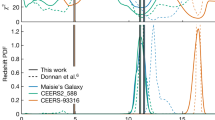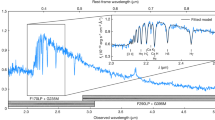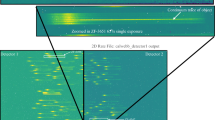Abstract
I WOULD like to call attention to one of the consequences of our current belief that there is a red-shift-distance relation for galaxies. It is accepted that as we observe increasingly distant galaxies we see them at earlier and earlier stages of their life history because of the finite velocity of light. If we could therefore observe sufficiently faint galaxies, we would see galaxies very close to their moment of creation, or even, conceptually, close to the moment of creation of the matter which would make up the galaxies. Empirically we find that the red-shifts of more distant galaxies increase and we must conclude with a high degree of certainty that, if we could see distant enough matter, it would be very young and have an extremely high red-shift. We can summarize this reasoning in the following statement: If we observe the universe near age zero, then it has a very large red-shift.
This is a preview of subscription content, access via your institution
Access options
Subscribe to this journal
Receive 51 print issues and online access
$199.00 per year
only $3.90 per issue
Buy this article
- Purchase on SpringerLink
- Instant access to full article PDF
Prices may be subject to local taxes which are calculated during checkout
Similar content being viewed by others
References
Ne'eman, Y., Astrophys. J., 141, 1303 (1965); Novikov, I. D., Sov. Astron., 8, 857 (1965); Harrison, E. R., Astron.J., 73, S182 (1968).
Hoyle, F., Eleventh Solvay Conf., La Structure et l'Evolution del'Univers, 57, (1958). Hoyle, F., Galaxies, Nuclei and Quasars, 125 (Harper and Row, New York, 1965).
Author information
Authors and Affiliations
Rights and permissions
About this article
Cite this article
ARP, H. Red-shifts of Very Young Objects. Nature 223, 386 (1969). https://doi.org/10.1038/223386a0
Received:
Issue date:
DOI: https://doi.org/10.1038/223386a0



